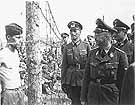
|
|
|

|

|

|

|
|
Click on an image to see a larger, more detailed picture.
|
|
|
|
|
| 1941: Mass Murder |

|
pg. 247 |

|
|
|
|
| |
 A Russian prisoner of war in Berdichev, Ukraine, eats from a can. Many Soviet POWs, however, were not so fortunate. The Nazis were ill-prepared to handle the millions of prisoners they captured, and they were not willing to allocate the necessary resources to provide for them. Many thousands of Russian POWs were forced to do without food and shelter. Russian prisoners were also the first victims to be gassed with Zyklon B at the Auschwitz death facility.
A Russian prisoner of war in Berdichev, Ukraine, eats from a can. Many Soviet POWs, however, were not so fortunate. The Nazis were ill-prepared to handle the millions of prisoners they captured, and they were not willing to allocate the necessary resources to provide for them. Many thousands of Russian POWs were forced to do without food and shelter. Russian prisoners were also the first victims to be gassed with Zyklon B at the Auschwitz death facility.
Photo: National Archives / United States Holocaust Memorial Museum Photo Archive
|
 Following the rapid German advance into the Soviet Union and the capture of thousands of Soviet soldiers, SS chief Heinrich Himmler visited this POW camp in Minsk, Belorussia. Himmler stares at a young and already emaciated Soviet prisoner. Millions of Soviet POWs were targeted for destruction by Nazi policies of neglect, abuse, malnutrition, and murder. The Wehrmacht, as well as Himmler's SS, were deeply implicated in this brutal behavior.
Following the rapid German advance into the Soviet Union and the capture of thousands of Soviet soldiers, SS chief Heinrich Himmler visited this POW camp in Minsk, Belorussia. Himmler stares at a young and already emaciated Soviet prisoner. Millions of Soviet POWs were targeted for destruction by Nazi policies of neglect, abuse, malnutrition, and murder. The Wehrmacht, as well as Himmler's SS, were deeply implicated in this brutal behavior.
Photo: National Archives/ United States Holocaust Memorial Museum Photo Archive
|
 Jacob Gens
Jacob Gens
Jacob Gens, leader of Vilna (Lithuania) Ghetto's Jewish Council, ruled his community with almost dictatorial power. Derisively called "King Jacob the First," Gens decided who would live and who would die. Convinced he could save Jews by demonstrating their value to the German economy, he selected those capable of "productive" labor and surrendered to the Nazis those who were "unproductive." During the 1941 Einsatzgruppen roundups, Gens personally inspected each Jew's work permit. Those too old, too weak, and too ill to work, or not in possession of the prized "yellow card" were delivered by Gens to the SS, who executed them. When reproached by Jewish religious leaders for his tactics, Gens defended his philosophy: "When they ask me for a thousand Jews, I hand them over. With the thousand, I save ten thousand." The Gestapo shot Gens in 1943, just days before liquidating the ghetto.
Photo: Yad Vashem / United States Holocaust Memorial Museum Photo Archive
|
|

|

|

|

|
 July 17, 1941: Twelve hundred Jews are murdered at Slonim, Belorussia.
July 17, 1941: Twelve hundred Jews are murdered at Slonim, Belorussia.
|
 July 17, 1941: Alfred Rosenberg is appointed Reich minister for the Occupied Eastern Territories to administer lands seized from the Soviet Union.
July 17, 1941: Alfred Rosenberg is appointed Reich minister for the Occupied Eastern Territories to administer lands seized from the Soviet Union.
|
 July 17-31, 1941: Thousands of Jews are murdered at Kishinev, Romania.
July 17-31, 1941: Thousands of Jews are murdered at Kishinev, Romania.
|
 July 20, 1941: A Jewish ghetto at Minsk, Belorussia, is established.
July 20, 1941: A Jewish ghetto at Minsk, Belorussia, is established.
|
 July 21, 1941: Forty-five Jews in Minsk, Belorussia, are forced to dig pits, then are roped together and tossed into the pits.
July 21, 1941: Forty-five Jews in Minsk, Belorussia, are forced to dig pits, then are roped together and tossed into the pits.
|
 July 21, 1941: Belorussians are ordered to bury Jews alive. When they refuse, Jewish and non-Jewish Belorussians alike are murdered by Einsatzkommandos.
July 21, 1941: Belorussians are ordered to bury Jews alive. When they refuse, Jewish and non-Jewish Belorussians alike are murdered by Einsatzkommandos.
|
 July 21, 1941: A concentration camp opens at Majdanek, Poland.
July 21, 1941: A concentration camp opens at Majdanek, Poland.
|
 July 22, 1941: France's Vichy government begins expropriation of Jewish businesses.
July 22, 1941: France's Vichy government begins expropriation of Jewish businesses.
|
 July 24, 1941: A ghetto is established in Kishinev, Ukraine.
July 24, 1941: A ghetto is established in Kishinev, Ukraine.
|
|
|
|
|
| 1941: Mass Murder |

|
pg. 247 |

|
|
The Holocaust Chronicle
© 2009 Publications International, Ltd.
|
|
